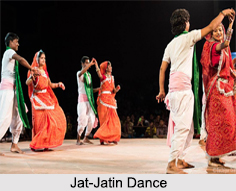 Folk Dances of Bihar are one of the most interesting aspects of Bihari culture. Bihar has a very rich tradition of dancing in its pristine quality. Most of the folk dances of Bihar reflect common life, people"s sorrows, accomplishments and problems. On important social gatherings, these dances are performed in group with musical instruments like tabla, dholak and harmonium accompanying the singers.
Folk Dances of Bihar are one of the most interesting aspects of Bihari culture. Bihar has a very rich tradition of dancing in its pristine quality. Most of the folk dances of Bihar reflect common life, people"s sorrows, accomplishments and problems. On important social gatherings, these dances are performed in group with musical instruments like tabla, dholak and harmonium accompanying the singers.
Over thousands of years various traditional dance forms have evolved in Bihar. The folk dance tradition in Bihar can be divided into three groups. First, the dance performed during poetry performance. The second stream is those of the tribal people who are closer to mother earth and their dances are heavily influenced by indigenous development. The third stream relates to the other regions of south Bihar. Most of the folk dances are religious in nature, in which, Gods and Goddesses are invoked through dance, performed to the rhythm of folk songs and music.
 Some of the prominent Folk Dances of Bihar include the following:
Some of the prominent Folk Dances of Bihar include the following:
Bidesia Dance
Bidesia Dance is a popular form of dance drama, which originated in the 20th century folk theatre and is prevalent in the Bhojpuri-speaking region of Bihar. Bhikhari Thakur is the creator of this dance form. Bidesia is actually a type of play which deals with the contradictory topics like tradition and modernity, the urban and the rural and the rich and the poor. This dance is used to execute the views of its creator. In Bidesia the female parts are played by the male actor-dancers. The costume for this dance is dhoti or trouser. In case of female roles artificial long hair is used.
Jat-Jatin Dance
Jat-Jatin is the most popular folk dance of North Bihar, namely in Mithila and Koshi region, which is performed as a couple dance. This dance presents many socially concerned topics like poverty, love, sorrow, arguments, etc. The original theme of this dance originated from the love story of Jat and Jatin.
Jumari Dance
The Jumari dance is one of the famous dances in Indian state of Bihar. Such dances are closely connected with the local culture and tradition. This dance has a similarity with the Garba dance of Gujarat. This dance form is specialized to the married women.
Jhijhian Dance
Jhijhian dance is a famous folk dance of Bihar. This dance is ritualistic in nature and a part of the ritual to appease the rain God Lord Indra, hoping to get a good rain for a year, for a resulting good quality harvest. In the harvesting season the men and women do their work in field along with this dance. The participants of the dance comprise a lead singer, harmonium player, a flute player, and a Dholak player. This is woman only dance show.
Kajari Dance
The theme of this dance is to prise the rainy season. Not only is the change in the climate but also the mental refreshment and relaxation also described in this dance form. This performance is done at the beginning of the rainy season.
Paika Dance
The Paika Dance is a famous dance in Bihar. The basic objective of the dance performance was the development of physical excitement and courageous activities of the dancing warriors. This dance is performed with shield and sword.
Sohar-Khilouna Dance
Sohar-Khilouna is a ceremonial dance to celebrate the pleasure of new birth in a family. It is celebrated all over the country with different traditional rituals. Sohar is sung in Bihar on the occasion of birth of a child.



















